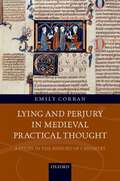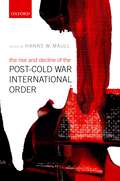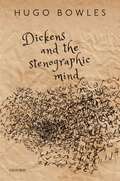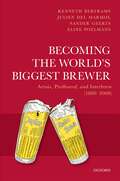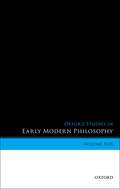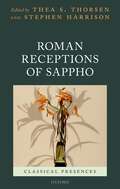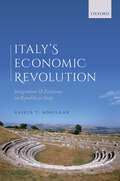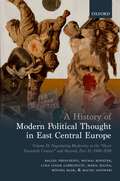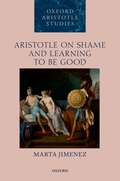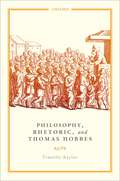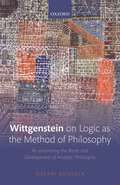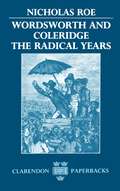- Table View
- List View
Lying and Perjury in Medieval Practical Thought: A Study in the History of Casuistry
by Emily CorranThought about lying and perjury became increasingly practical from the end of the twelfth century in Western Europe. At this time, a distinctive way of thinking about deception and false oaths appeared in the schools of Paris and Bologna, most notably in the Summa de Sacramentis et Animae Consiliis of Peter the Chanter. This kind of thought was concerned with moral dilemmas and the application of moral rules in exceptional cases. It was a tradition which continued in pastoral writings of the thirteenth century, the practical moral questions addressed by theologians in universities in the second half of the thirteenth century, and in the Summae de Casibus Conscientiae of the late Middle Ages. Lying and Perjury in Medieval Practical Thought argues that medieval practical ethics of this sort can usefully be described as casuistry - a term for the discipline of moral theology that became famous during the Counter-Reformation. This can be seen in the origins of the concept of equivocation, an idea that was explored in medieval literature with varying degrees of moral ambiguity. From the turn of the thirteenth century, the concept was adopted by canon lawyers and theologians, as a means of exploring questions about exceptional situations in ethics. It has been assumed in the past that equivocation, and the casuistry of lying was an academic discourse invented in the sixteenth century in order to evade moral obligations. This study reveals that casuistry in the Middle Ages was developed in ecclesiastical thought as part of an effort to explain how to follow moral rules in ambiguous and perplexing cases.
Lying and Perjury in Medieval Practical Thought: A Study in the History of Casuistry
by Emily CorranThought about lying and perjury became increasingly practical from the end of the twelfth century in Western Europe. At this time, a distinctive way of thinking about deception and false oaths appeared in the schools of Paris and Bologna, most notably in the Summa de Sacramentis et Animae Consiliis of Peter the Chanter. This kind of thought was concerned with moral dilemmas and the application of moral rules in exceptional cases. It was a tradition which continued in pastoral writings of the thirteenth century, the practical moral questions addressed by theologians in universities in the second half of the thirteenth century, and in the Summae de Casibus Conscientiae of the late Middle Ages. Lying and Perjury in Medieval Practical Thought argues that medieval practical ethics of this sort can usefully be described as casuistry - a term for the discipline of moral theology that became famous during the Counter-Reformation. This can be seen in the origins of the concept of equivocation, an idea that was explored in medieval literature with varying degrees of moral ambiguity. From the turn of the thirteenth century, the concept was adopted by canon lawyers and theologians, as a means of exploring questions about exceptional situations in ethics. It has been assumed in the past that equivocation, and the casuistry of lying was an academic discourse invented in the sixteenth century in order to evade moral obligations. This study reveals that casuistry in the Middle Ages was developed in ecclesiastical thought as part of an effort to explain how to follow moral rules in ambiguous and perplexing cases.
The Rise and Decline of the Post-Cold War International Order
This books surveys the evolution of the international order in the quarter century since the end of the Cold War through the prism of developments in key regional and functional parts of the 'liberal international order 2.0' (LIO 2.0) and the roles played by two key ordering powers, the United States and the People's Republic of China. Among the partial orders analysed in the individual chapters are the regions of Europe, the Middle East and East Asia and the international regimes dealing with international trade, climate change, nuclear weapons, cyber space, and international public health emergencies, such as SARS and ZIKA. To assess developments in these various segments of the LIO 2.0, and to relate them to developments in the two other crucial levels of political order, order within nation-states, and at the global level, the volume develops a comprehensive, integrated framework of analysis that allows systematic comparison of developments across boundaries between segments and different levels of the international order. Using this framework, the book presents a holistic assessment of the trajectory of the international order over the last decades, the rise, decline, and demise of the LIO 2.0, and causes of the dangerous erosion of international order over the last decade.
The Rise and Decline of the Post-Cold War International Order
by Hanns W. MaullThis books surveys the evolution of the international order in the quarter century since the end of the Cold War through the prism of developments in key regional and functional parts of the 'liberal international order 2.0' (LIO 2.0) and the roles played by two key ordering powers, the United States and the People's Republic of China. Among the partial orders analysed in the individual chapters are the regions of Europe, the Middle East and East Asia and the international regimes dealing with international trade, climate change, nuclear weapons, cyber space, and international public health emergencies, such as SARS and ZIKA. To assess developments in these various segments of the LIO 2.0, and to relate them to developments in the two other crucial levels of political order, order within nation-states, and at the global level, the volume develops a comprehensive, integrated framework of analysis that allows systematic comparison of developments across boundaries between segments and different levels of the international order. Using this framework, the book presents a holistic assessment of the trajectory of the international order over the last decades, the rise, decline, and demise of the LIO 2.0, and causes of the dangerous erosion of international order over the last decade.
Dickens and the Stenographic Mind
by Hugo BowlesInitially described by Dickens as a 'savage stenographic mystery', shorthand was to become an essential and influential part of his toolkit as a writer. In this ground-breaking interdisciplinary study, Hugo Bowles tells the story of Dickens's stenographic journey from his early encounters with the 'despotic' shorthand symbols of Gurney's Brachygraphy in 1828 to his lifelong commitment to shorthand for reporting, letter writing, copying, and note-taking. Drawing on empirical evidence from Dickens's shorthand notebooks, Dickens and the Stenographic Mind forensically explores Dickens's unique ability to write in two graphic codes, offering an original critique of the impact of shorthand on Dickens's mental processing of language. The author uses insights from morphology, phonetics, and the psychology of reading to show how Dickens's biscriptal habits created a unique stenographic mindset that was then translated into novel forms of creative writing. The volume argues that these new scriptal arrangements, which include phonetic speech, stenographic patterns of letters in individual words, phonaesthemes, and literary representations of shorthand-related acts of reading and writing, created reading puzzles that bound Dickens and his readers together in a new form of stenographic literacy. Clearly written and cogently argued, Dickens and the Stenographic Mind not only opens up new evidence from a little known area of Dickens's professional life to expert scrutiny, but is highly relevant to a number of important debates in Victorian studies including orality and literacy in the nineteenth century, the role of voice and voicing in Dickens's writing process, his relationship with his readers, and his various writing personae as law reporter, sketch-writer, journalist, and novelist.
Dickens and the Stenographic Mind
by Hugo BowlesInitially described by Dickens as a 'savage stenographic mystery', shorthand was to become an essential and influential part of his toolkit as a writer. In this ground-breaking interdisciplinary study, Hugo Bowles tells the story of Dickens's stenographic journey from his early encounters with the 'despotic' shorthand symbols of Gurney's Brachygraphy in 1828 to his lifelong commitment to shorthand for reporting, letter writing, copying, and note-taking. Drawing on empirical evidence from Dickens's shorthand notebooks, Dickens and the Stenographic Mind forensically explores Dickens's unique ability to write in two graphic codes, offering an original critique of the impact of shorthand on Dickens's mental processing of language. The author uses insights from morphology, phonetics, and the psychology of reading to show how Dickens's biscriptal habits created a unique stenographic mindset that was then translated into novel forms of creative writing. The volume argues that these new scriptal arrangements, which include phonetic speech, stenographic patterns of letters in individual words, phonaesthemes, and literary representations of shorthand-related acts of reading and writing, created reading puzzles that bound Dickens and his readers together in a new form of stenographic literacy. Clearly written and cogently argued, Dickens and the Stenographic Mind not only opens up new evidence from a little known area of Dickens's professional life to expert scrutiny, but is highly relevant to a number of important debates in Victorian studies including orality and literacy in the nineteenth century, the role of voice and voicing in Dickens's writing process, his relationship with his readers, and his various writing personae as law reporter, sketch-writer, journalist, and novelist.
Becoming the World's Biggest Brewer: Artois, Piedboeuf, and Interbrew (1880-2000)
by Kenneth Bertrams Julien Del Marmol Sander Geerts Eline PoelmansAB InBev is today's uncontested world leader of the beer market. It represents over 20% of global beer sales, with more than 450 million hectolitre a year flowing all around the world. Its Belgian predecessor, Interbrew, was a success story stemming from the 1971 secret merger of the country's two leading brewers: Artois and Piedboeuf. Based on material originating from company and private archives as well as interviews with managers and key family actors, this is the first study to explore the history of the company through the nineteenth and twentieth centuries. The story starts in the mid-nineteenth century with the scientific breakthroughs that revolutionised the beer industry and allowed both Artois and Piedboeuf to prosper in a local environment. Instrumental in this respect were the respective families and their successive heirs in stabilizing and developing their firms. Despite the intense difficulties of two world wars in the decades to follow, they emerged stronger than ever and through the 1960s became undisputed leaders in the national market. Then, in an unprecedented move, Artois and Piedboeuf secretly merged their shareholding in 1971, though keeping their operations separate until 1987 when they openly and operationally merged to become Interbrew. Throughout their histories Artois, Piedboeuf, and their successor companies have kept a controlling family ownership. This book provides a unique insight into the complex history of these three family breweries and their path to becoming a prominent global company, and the growth and consolidation of the beer market through the nineteenth and twentieth centuries.
Becoming the World's Biggest Brewer: Artois, Piedboeuf, and Interbrew (1880-2000)
by Kenneth Bertrams Julien Del Marmol Sander Geerts Eline PoelmansAB InBev is today's uncontested world leader of the beer market. It represents over 20% of global beer sales, with more than 450 million hectolitre a year flowing all around the world. Its Belgian predecessor, Interbrew, was a success story stemming from the 1971 secret merger of the country's two leading brewers: Artois and Piedboeuf. Based on material originating from company and private archives as well as interviews with managers and key family actors, this is the first study to explore the history of the company through the nineteenth and twentieth centuries. The story starts in the mid-nineteenth century with the scientific breakthroughs that revolutionised the beer industry and allowed both Artois and Piedboeuf to prosper in a local environment. Instrumental in this respect were the respective families and their successive heirs in stabilizing and developing their firms. Despite the intense difficulties of two world wars in the decades to follow, they emerged stronger than ever and through the 1960s became undisputed leaders in the national market. Then, in an unprecedented move, Artois and Piedboeuf secretly merged their shareholding in 1971, though keeping their operations separate until 1987 when they openly and operationally merged to become Interbrew. Throughout their histories Artois, Piedboeuf, and their successor companies have kept a controlling family ownership. This book provides a unique insight into the complex history of these three family breweries and their path to becoming a prominent global company, and the growth and consolidation of the beer market through the nineteenth and twentieth centuries.
Oxford Studies in Early Modern Philosophy, Volume VIII (Oxford Studies in Early Modern Philosophy)
Oxford Studies in Early Modern Philosophy is an annual series, presenting a selection of the best current work in the history of early modern philosophy. It focuses on the seventeenth and eighteenth centuries—the extraordinary period of intellectual flourishing that begins, very roughly, with Descartes and his contemporaries and ends with Kant. It also publishes papers on thinkers or movements outside of that framework, provided they are important in illuminating early modern thought. The articles in OSEMP will be of importance to specialists within the discipline, but the editors also intend that they should appeal to a larger audience of philosophers, intellectual historians, and others who are interested in the development of modern thought.
Oxford Studies in Early Modern Philosophy, Volume VIII (Oxford Studies in Early Modern Philosophy)
by Donald Rutherford Daniel GarberOxford Studies in Early Modern Philosophy is an annual series, presenting a selection of the best current work in the history of early modern philosophy. It focuses on the seventeenth and eighteenth centuries—the extraordinary period of intellectual flourishing that begins, very roughly, with Descartes and his contemporaries and ends with Kant. It also publishes papers on thinkers or movements outside of that framework, provided they are important in illuminating early modern thought. The articles in OSEMP will be of importance to specialists within the discipline, but the editors also intend that they should appeal to a larger audience of philosophers, intellectual historians, and others who are interested in the development of modern thought.
Servilia and her Family
by Susan TreggiariServilia is often cited as one of the most influential women of the late Roman Republic. Though she was a high-born patrician, her grandfather died disgraced and her controversial father was killed before he could stand for the consulship; she herself married twice, but both husbands were mediocre. Nevertheless, her position in the ruling class still afforded her significant social and political power, and it is likely that she masterminded the distinguished marriages of her one son, Brutus, and her three daughters. During her second marriage she began an affair with Iulius Caesar, which probably lasted for the rest of his life and is further indicative of the force of her charm and her exceptional intelligence. The patchiness of the sources means that a full biography is impossible, though in suggesting connections between the available evidence and the speculative possibilities open to women of Servilia's status this volume aims to offer an insightful reconstruction of her life and position both as a member of the senatorial nobility and within her extended and nuclear family. The best attested period of Servilia's life, for which the chief source is Cicero's letters, follows the murder of Caesar by her son and her son-in-law, Cassius, who were leaders among the crowd of conspirators in the Senate House on the Ides of March in 44 BC. We find her energetically working to protect the assassins' interests, also defending her grandchildren by the Caesarian Lepidus when he was declared a public enemy and his property threatened with confiscation. Exploring the role she played during these turbulent years of the late Republic reveals much about the ways in which Romans of both sexes exerted influence and sought to control outcomes, as well as about the place of women in high society, allowing us to conclude that Servilia wielded her social and political power effectively, though with discretion and within conventional limits.
Servilia and her Family
by Susan TreggiariServilia is often cited as one of the most influential women of the late Roman Republic. Though she was a high-born patrician, her grandfather died disgraced and her controversial father was killed before he could stand for the consulship; she herself married twice, but both husbands were mediocre. Nevertheless, her position in the ruling class still afforded her significant social and political power, and it is likely that she masterminded the distinguished marriages of her one son, Brutus, and her three daughters. During her second marriage she began an affair with Iulius Caesar, which probably lasted for the rest of his life and is further indicative of the force of her charm and her exceptional intelligence. The patchiness of the sources means that a full biography is impossible, though in suggesting connections between the available evidence and the speculative possibilities open to women of Servilia's status this volume aims to offer an insightful reconstruction of her life and position both as a member of the senatorial nobility and within her extended and nuclear family. The best attested period of Servilia's life, for which the chief source is Cicero's letters, follows the murder of Caesar by her son and her son-in-law, Cassius, who were leaders among the crowd of conspirators in the Senate House on the Ides of March in 44 BC. We find her energetically working to protect the assassins' interests, also defending her grandchildren by the Caesarian Lepidus when he was declared a public enemy and his property threatened with confiscation. Exploring the role she played during these turbulent years of the late Republic reveals much about the ways in which Romans of both sexes exerted influence and sought to control outcomes, as well as about the place of women in high society, allowing us to conclude that Servilia wielded her social and political power effectively, though with discretion and within conventional limits.
Roman Receptions of Sappho (Classical Presences)
Sappho, a towering figure in Western culture, is an exemplary case in the history of classical receptions. There are three prominent reasons for this. Firstly, Sappho is associated with some of the earliest poetry in the classical tradition, which makes her reception history one of the longest we know of. Furthermore, Sappho's poetry promotes ideologically challenging concepts such as female authority and homoeroticism, which have prompted very conspicuous interpretative strategies to deal with issues of gender and sexuality, revealing the values of the societies that have received her works through time. Finally, Sappho's legacy has been very well explored from the perspective of reception studies: important investigations have been made into responses both to her as poet-figure and to her poetry from her earliest reception through to our own time. However, one of the few eras in Sappho's longstanding reception history that has not been systematically explored before this volume is the Roman period. The omission is a paradox. Receptions of Sappho can be traced in more than eighteen Roman poets, among them many of the most central authors in the history of Latin literature. Surely, few other Greek poets can rival the impact of Sappho at Rome. This important fact calls out for a systematic approach to Sappho's Roman reception, which is the aim of Roman Receptions of Sappho that focuses on the poetry of the central period of Roman literary history, from the time of Lucretius to that of Martial.
Roman Receptions of Sappho (Classical Presences)
by Stephen Harrison Thea S. ThorsenSappho, a towering figure in Western culture, is an exemplary case in the history of classical receptions. There are three prominent reasons for this. Firstly, Sappho is associated with some of the earliest poetry in the classical tradition, which makes her reception history one of the longest we know of. Furthermore, Sappho's poetry promotes ideologically challenging concepts such as female authority and homoeroticism, which have prompted very conspicuous interpretative strategies to deal with issues of gender and sexuality, revealing the values of the societies that have received her works through time. Finally, Sappho's legacy has been very well explored from the perspective of reception studies: important investigations have been made into responses both to her as poet-figure and to her poetry from her earliest reception through to our own time. However, one of the few eras in Sappho's longstanding reception history that has not been systematically explored before this volume is the Roman period. The omission is a paradox. Receptions of Sappho can be traced in more than eighteen Roman poets, among them many of the most central authors in the history of Latin literature. Surely, few other Greek poets can rival the impact of Sappho at Rome. This important fact calls out for a systematic approach to Sappho's Roman reception, which is the aim of Roman Receptions of Sappho that focuses on the poetry of the central period of Roman literary history, from the time of Lucretius to that of Martial.
Italy's Economic Revolution: Integration and Economy in Republican Italy
by Saskia T. RoselaarThe Roman conquest of Italy in the Republican period (from c. 400 to 50 BC) led to widespread economic changes in which the conquered Italians played an important role. Italy's Economic Revolution analyses the integration of Italy during this period and explores the interplay between economic activities and unification in its civic, legal, social, and cultural senses. On one hand, it investigates whether Italy became more integrated economically following the Roman conquest and traces the widely varying local reactions to the globalization of the Italian economy; on the other, it examines whether and how economic activities carried out by Italians contributed to the integration of the Italian peoples into the Roman framework. Throughout the Republican period, Italians were able to profit from the expansion of the Roman dominion in the Mediterranean and the new economic opportunities it afforded, which led to gradual changes in institutions, culture, and language: through overseas trade and commercial agriculture they had gained significant wealth, which they invested in the Italian landscape, and they were often ahead of Romans when it came to engagement with Hellenistic culture. However, their economic prosperity and cultural sophistication did not lead to civic equality, nor to equal opportunities to exploit the territories the Italians had conquered under Rome's lead. Eventually the Italians rose in rebellion against Rome in the Social War of 91-88 BC, after which they were finally granted Roman citizenship. This volume investigates not only whether and how economic interaction played a role in this civic integration, but also highlights the importance of Roman citizenship as an instrument of further economic, political, social, and cultural integration between Romans and Italians.
Italy's Economic Revolution: Integration and Economy in Republican Italy
by Saskia T. RoselaarThe Roman conquest of Italy in the Republican period (from c. 400 to 50 BC) led to widespread economic changes in which the conquered Italians played an important role. Italy's Economic Revolution analyses the integration of Italy during this period and explores the interplay between economic activities and unification in its civic, legal, social, and cultural senses. On one hand, it investigates whether Italy became more integrated economically following the Roman conquest and traces the widely varying local reactions to the globalization of the Italian economy; on the other, it examines whether and how economic activities carried out by Italians contributed to the integration of the Italian peoples into the Roman framework. Throughout the Republican period, Italians were able to profit from the expansion of the Roman dominion in the Mediterranean and the new economic opportunities it afforded, which led to gradual changes in institutions, culture, and language: through overseas trade and commercial agriculture they had gained significant wealth, which they invested in the Italian landscape, and they were often ahead of Romans when it came to engagement with Hellenistic culture. However, their economic prosperity and cultural sophistication did not lead to civic equality, nor to equal opportunities to exploit the territories the Italians had conquered under Rome's lead. Eventually the Italians rose in rebellion against Rome in the Social War of 91-88 BC, after which they were finally granted Roman citizenship. This volume investigates not only whether and how economic interaction played a role in this civic integration, but also highlights the importance of Roman citizenship as an instrument of further economic, political, social, and cultural integration between Romans and Italians.
A History of Modern Political Thought in East Central Europe: Volume II: Negotiating Modernity in the 'Short Twentieth Century' and Beyond, Part II: 1968-2018
by Balázs Trencsenyi Michal Kopeček Luka Lisjak Gabrijelčič Maria Falina Mónika BaárA History of Modern Political Thought in East Central Europe is a synthetic work, authored by an international team of researchers, covering twenty national cultures and 250 years. It goes beyond the conventional nation-centered narratives and presents a novel vision especially sensitive to the cross-cultural entanglement of political ideas and discourses. Its principal aim is to make these cultures available for the global 'market of ideas' and revisit some of the basic assumptions about the history of modern political thought, and modernity as such. The present volume is the final part of the project, following Volume I: Negotiating Modernity in the 'Long Nineteenth Century', and Volume II, Part I: Negotiating Modernity in the 'Short Twentieth Century' (1918-1968) (OUP, 2018). Its starting point is the defeat of the vision of 'socialism with a human face' in 1968 and the political discourses produced by the various 'consolidation' or 'normalization' regimes. It continues with mapping the exile communities' and domestic dissidents' critical engagement with the local democratic and anti-democratic traditions as well as with global trends. Rather than achieving the coveted 'end of history', however, the liberal democratic order created in East Central Europe after 1989 became increasingly contested from left and right alike. Thus, instead of a comfortable conclusion pointing to the European integration of most of these countries, the book closes with a reflection on the fragility of democracy in this part of the world and beyond.
A History of Modern Political Thought in East Central Europe: Volume II: Negotiating Modernity in the 'Short Twentieth Century' and Beyond, Part II: 1968-2018
by Maria Falina Michal Kopeček Balázs Trencsenyi Luka Lisjak Gabrijelčič Mónika BaárA History of Modern Political Thought in East Central Europe is a synthetic work, authored by an international team of researchers, covering twenty national cultures and 250 years. It goes beyond the conventional nation-centered narratives and presents a novel vision especially sensitive to the cross-cultural entanglement of political ideas and discourses. Its principal aim is to make these cultures available for the global 'market of ideas' and revisit some of the basic assumptions about the history of modern political thought, and modernity as such. The present volume is the final part of the project, following Volume I: Negotiating Modernity in the 'Long Nineteenth Century', and Volume II, Part I: Negotiating Modernity in the 'Short Twentieth Century' (1918-1968) (OUP, 2018). Its starting point is the defeat of the vision of 'socialism with a human face' in 1968 and the political discourses produced by the various 'consolidation' or 'normalization' regimes. It continues with mapping the exile communities' and domestic dissidents' critical engagement with the local democratic and anti-democratic traditions as well as with global trends. Rather than achieving the coveted 'end of history', however, the liberal democratic order created in East Central Europe after 1989 became increasingly contested from left and right alike. Thus, instead of a comfortable conclusion pointing to the European integration of most of these countries, the book closes with a reflection on the fragility of democracy in this part of the world and beyond.
Aristotle on Shame and Learning to Be Good (Oxford Aristotle Studies Series)
by Marta JimenezMarta Jimenez presents a novel interpretation of Aristotle's account of the role of shame in moral development. Despite shame's bad reputation as a potential obstacle to the development of moral autonomy, Jimenez argues that shame is for Aristotle the proto-virtue of those learning to be good, since it is the emotion that equips them with the seeds of virtue. Other emotions such as friendliness, righteous indignation, emulation, hope, and even spiritedness may play important roles on the road to virtue. However, shame is the only one that Aristotle repeatedly associates with moral progress. The reason is that shame can move young agents to perform good actions and avoid bad ones in ways that appropriately resemble not only the external behavior but also the orientation and receptivity to moral value characteristic of virtuous people. Through an analysis of the different cases of pseudo-courage and the passages on shame in Aristotle's ethical treatises, Jimenez argues that shame places young people on the path to becoming good by turning their attention to considerations about the perceived nobility and praiseworthiness of their own actions and character. Although they are not yet virtuous, learners with a sense of shame can appreciate the value of the noble and guide their actions by a genuine interest in doing the right thing. Shame, thus, enables learners to perform virtuous actions in the right way before they possess practical wisdom or stable dispositions of character. This proposal solves a long-debated problem concerning Aristotle's notion of habituation by showing that shame provides motivational continuity between the actions of the learners and the virtuous dispositions that they will eventually acquire
Philosophy, Rhetoric, and Thomas Hobbes
by Timothy RaylorThomas Hobbes claimed to have founded the discipline of civil philosophy (political science). The claim did not go uncontested and in recent years the relationship of philosophical reasoning to rhetorical persuasion in Hobbes's work has become a significant area of discussion, as scholars attempt to align his disparaging remarks about rhetoric with his dazzling practice of it in works like Leviathan. The dominant view is that, having rejected an early commitment to humanism and with it rhetoric when he adopted the 'scientific' approach to philosophy in the late 1630s, Hobbes later came to re-embrace it as an essential aid to or part of philosophy. Philosophy, Rhetoric, and Thomas Hobbes proposes that Hobbes was, from first to last, dubious about the place of rhetoric in civil society, and came to see it as a pernicious presence within philosophy - a position from which he did not retreat. It offers a fresh and expanded picture of Hobbes's humanism by examining his years as a country house tutor; his teaching and his translation of Thucydides, the influence on him of Bacon, and the range of his early natural historical and philosophical interests. In demonstrating the distinctively Aristotelian character of his understanding of rhetoric, the book also revisits the new approach to philosophy Hobbes adopted at the end of the 1630s, clarifying the nature and scope of his concern about the contamination of philosophy and political life by the procedures of rhetorical argumentation.
Philosophy, Rhetoric, and Thomas Hobbes
by Timothy RaylorThomas Hobbes claimed to have founded the discipline of civil philosophy (political science). The claim did not go uncontested and in recent years the relationship of philosophical reasoning to rhetorical persuasion in Hobbes's work has become a significant area of discussion, as scholars attempt to align his disparaging remarks about rhetoric with his dazzling practice of it in works like Leviathan. The dominant view is that, having rejected an early commitment to humanism and with it rhetoric when he adopted the 'scientific' approach to philosophy in the late 1630s, Hobbes later came to re-embrace it as an essential aid to or part of philosophy. Philosophy, Rhetoric, and Thomas Hobbes proposes that Hobbes was, from first to last, dubious about the place of rhetoric in civil society, and came to see it as a pernicious presence within philosophy - a position from which he did not retreat. It offers a fresh and expanded picture of Hobbes's humanism by examining his years as a country house tutor; his teaching and his translation of Thucydides, the influence on him of Bacon, and the range of his early natural historical and philosophical interests. In demonstrating the distinctively Aristotelian character of his understanding of rhetoric, the book also revisits the new approach to philosophy Hobbes adopted at the end of the 1630s, clarifying the nature and scope of his concern about the contamination of philosophy and political life by the procedures of rhetorical argumentation.
Wittgenstein on Logic as the Method of Philosophy: Re-examining the Roots and Development of Analytic Philosophy
by Oskari KuuselaIn Wittgenstein on Logic as the Method of Philosophy, Oskari Kuusela examines Wittgenstein's early and late philosophies of logic, situating their philosophical significance in early and middle analytic philosophy with particular reference to Frege, Russell, Carnap, and Strawson. He argues that not only the early but also the later Wittgenstein sought to further develop the logical-philosophical approaches of his contemporaries. Throughout his career Wittgenstein's aim was to resolve problems with and address the limitations of Frege's and Russell's accounts of logic and their logical methodologies so as to achieve the philosophical progress that originally motivated the logical-philosophical approach. By re-examining the roots and development of analytic philosophy, Kuusela seeks to open up covered up paths for the further development of analytic philosophy. Offering a novel interpretation of the philosopher, he explains how Wittgenstein extends logical methodology beyond calculus-based logical methods and how his novel account of the status of logic enables one to do justice to the complexity and richness of language use and thought while retaining rigour and ideals of logic such as simplicity and exactness. In addition, this volume outlines the new kind of non-empiricist naturalism developed in Wittgenstein's later work and explaining how his account of logic can be used to dissolve the long-standing methodological dispute between the ideal and ordinary language schools of analytic philosophy. It is of interest to scholars, researchers, and advance students of philosophy interested in engaging with a number of scholarly debates.
Wittgenstein on Logic as the Method of Philosophy: Re-examining the Roots and Development of Analytic Philosophy
by Oskari KuuselaIn Wittgenstein on Logic as the Method of Philosophy, Oskari Kuusela examines Wittgenstein's early and late philosophies of logic, situating their philosophical significance in early and middle analytic philosophy with particular reference to Frege, Russell, Carnap, and Strawson. He argues that not only the early but also the later Wittgenstein sought to further develop the logical-philosophical approaches of his contemporaries. Throughout his career Wittgenstein's aim was to resolve problems with and address the limitations of Frege's and Russell's accounts of logic and their logical methodologies so as to achieve the philosophical progress that originally motivated the logical-philosophical approach. By re-examining the roots and development of analytic philosophy, Kuusela seeks to open up covered up paths for the further development of analytic philosophy. Offering a novel interpretation of the philosopher, he explains how Wittgenstein extends logical methodology beyond calculus-based logical methods and how his novel account of the status of logic enables one to do justice to the complexity and richness of language use and thought while retaining rigour and ideals of logic such as simplicity and exactness. In addition, this volume outlines the new kind of non-empiricist naturalism developed in Wittgenstein's later work and explaining how his account of logic can be used to dissolve the long-standing methodological dispute between the ideal and ordinary language schools of analytic philosophy. It is of interest to scholars, researchers, and advance students of philosophy interested in engaging with a number of scholarly debates.
Wordsworth and Coleridge: The Radical Years
by Nicholas RoeThis volume offers a reappraisal of Wordsworth's and Coleridge's radical careers before their emergence as major poets. Updated, revised, and with new manuscript material, this expanded new edition responds to the most significant critical work on Wordsworth's and Coleridge's radical careers in the three decades since the book first appeared. Fresh material is drawn from newspapers and printed sources; the poetry of 1798 is given more detailed attention, and the critical debate surrounding new historicism is freshly appraised. A new introduction reflects on how the book was originally researched, offers new insights into the notorious Léonard Bourdon killings of 1793, and revisits John Thelwall's predicament in 1798. University politics, radical dissent, and first-hand experiences of Revolutionary France form the substance of the opening chapters. Wordsworth's and Coleridge's relations with William Godwin and John Thelwall are tracked in detail, and both poets are shown to have been closely connected with the London Corresponding Society. Godwin's diaries, now accessible in electronic form, have been drawn upon extensively to supplement the narrative of his intellectual influence. Offering a comparative perspective on the poets and their contemporaries, the book investigates the ways in which 1790s radicals coped with personal crisis, arrests, trumped-up charges, and prosecutions. Some fled the country, becoming refugees; others went underground, hiding away as inner émigrés. Against that backdrop, Wordsworth and Coleridge opted for a different revolution: they wrote poems that would change the way people thought.
Wordsworth and Coleridge: The Radical Years
by Nicholas RoeThis volume offers a reappraisal of Wordsworth's and Coleridge's radical careers before their emergence as major poets. Updated, revised, and with new manuscript material, this expanded new edition responds to the most significant critical work on Wordsworth's and Coleridge's radical careers in the three decades since the book first appeared. Fresh material is drawn from newspapers and printed sources; the poetry of 1798 is given more detailed attention, and the critical debate surrounding new historicism is freshly appraised. A new introduction reflects on how the book was originally researched, offers new insights into the notorious Léonard Bourdon killings of 1793, and revisits John Thelwall's predicament in 1798. University politics, radical dissent, and first-hand experiences of Revolutionary France form the substance of the opening chapters. Wordsworth's and Coleridge's relations with William Godwin and John Thelwall are tracked in detail, and both poets are shown to have been closely connected with the London Corresponding Society. Godwin's diaries, now accessible in electronic form, have been drawn upon extensively to supplement the narrative of his intellectual influence. Offering a comparative perspective on the poets and their contemporaries, the book investigates the ways in which 1790s radicals coped with personal crisis, arrests, trumped-up charges, and prosecutions. Some fled the country, becoming refugees; others went underground, hiding away as inner émigrés. Against that backdrop, Wordsworth and Coleridge opted for a different revolution: they wrote poems that would change the way people thought.
